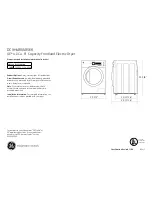
16
CONNECTING THE INLET HOSE
The dryer must be connected to the cold water tap
using the new water supply hose. Do not use old hoses.
NOTE:
• Water supply pressure must be between 21.8 PSI and
116 PSI (150~800 kPa).
• Do not strip or cross-thread when connecting inlet hose
to the valve.
• If the water supply pressure is more than 116 PSI (800
kPa), a pressure reducing valve should be installed.
• Periodically check the condition of the hose and
replace the hose if necessary.
• Replace inlet hoses after 5 years of use to reduce the
risk of hose failure.
• Record hose installation or replacement dates on the
hoses for future reference.
1. Check the rubber seal in the inlet hose. Two rubber
seals are supplied with each inlet hose. They are used
for preventing water leaks. Make sure the connection
to the cold water tap is tight.
2. Check the installation type.
Connect all water supply hoses tightly by hand and
then tighten another 2/3 turn with pliers.
WITH WASHER:
When connecting the dryer to the same
faucet as a washer.
a. Shut o
ff
the cold water tap and remove the washer
hose.
b. Connect the short hose to the Y-conncetor using one
of the hose washers.
c. Connect the other end of the short hose to the cold
water faucet.
d. Connect the long dryer hose to one side of theY-con-
nector and connect the washer hose to the other side.
WITHOUT WASHER:
If the dryer does not share the
cold water tap with a washer.
a. Connect the straight end of the long hose to the cold
water faucet.
INSTALLATION INSTRUCTIONS
NOTE:
• Before connecting the water line to the dryer,
fl
ush
several gallons of water into a drain or bucket. This
will help prevent foreign particles such as sand and
scale from cloggong the dryer inlet valve.
• Do not overtighten. Damage to the coupling can
result.
3. Connect the hose to the dryer.
• Connect the water supply hose to the dryer inlet
valve tightly by hand and then tighten another 2/3
turn with pliers. Make sure that there are no kinks in
the hoses and that they are not crushed.
4. Turn on the cold water faucet.
5. Check for leaks at the Y-connector (if used) and all
hoses.
NOTE:
• If any leaks are found, shut o
ff
the water faucet,
remove the hose and check the condition of the hose
washer.
Hose
connector
Y connector
Rubber
seal
Long
hose
WITH WASHER
WITHOUT WASHER
Short
hose
Y connector
Summary of Contents for 796.6141 Series
Page 71: ...71 ...
















































